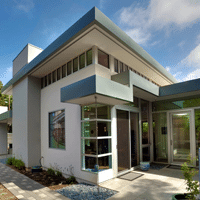Most people have trouble drumming up business when they start their own company, but Gary Diebel started his company because he was getting so much work, much of it personal requests for residential projects. He formed Diebel and Company Architectural Studio in 1990, and for more than 20 years the small firm has been designing sophisticated, sustainable Northern California homes, including the 434 House in Palo Alto, which was completed early last year. Featuring modern architecture and calming blue accents, the home is the picture of California cool. Diebel spoke with gb&d about the house and its sustainable features.
gb&d: Tell me about the 434 House. What did the project entail?
Gary Diebel: The initial house located on the property was actually the home the client grew up in—his parents originally bought the house in the summer of 1940. We started from scratch, and the client wanted a one-story home that was clean and modern and had tall ceilings. This was actually a very unique project because the ceilings had different heights, spanning 10, 12, and 14 feet. The house is also very linear; it’s long and narrow. It was also important that we made sure that natural breezes would come through the home. In this area, it can be 80 degrees during the day and then drop down to 50 degrees at night. A lot of homes around here don’t even have air conditioners because it cools down so much, so we wanted to be mindful of how this would affect the home.

Diebel hung a stainless-steel rain chain from the roof to the ground so that rainwater will run off the roof and into the ground drainage system. Photos: Kevin Ng
gb&d: Your firm has become known for its attention to site orientation and its focus on taking advantage of natural lighting. Were these features incorporated into the 434 House?
Diebel: Definitely. We use Nemetschek Vectorworks building-information-modeling (BIM) software, which has a sunlight-orientation feature that can analyze how light will be seen in the home depending on the time of day, the location, and the situation. There’s a misconception that heating is always the biggest energy consumer in a home, but I’ve found that it’s often the lighting. Taking advantage of natural lighting is sustainable, but it also brings a lot of warmth to a home. I’ve actually used this particular software for a long time, but it went by a different name previously. My experience with BIM technology goes back 12 years. It helps in … that it’s more efficient and accurate. Using a 3-D model, you can get an understanding of how sunlight will come into the home. It cuts down on the amount of waste that’s produced, and it cuts down on the number of mistakes that can be made. Nothing is drawn by hand anymore.
gb&d: What are some of the home’s other sustainable features?
Diebel: Water and pollution are both issues in the state of California, so whenever you can cut down on either it’s a good thing. The home has an extensive system for reclaiming storm water. That water is then used to irrigate the property. This system also keeps the storm-water runoff from flushing debris into storm drains, which drain into the San Francisco Bay. The home also has low-flow fixtures, including TOTO toilets, Hansgrohe Talis sinks, and Hansgrohe 3-jet showerheads. Because the house is built on a concrete slab and has very high ceilings, we needed something that would regulate heat well, so we utilized radiant heat flooring. It was installed by Anderson Radiant Heating and it has PEX tubing in the concrete floor slab. The home also has a Nortiz-model tankless water heater. The boiler in the heater is a Triangle Tube Prestige Solo 110 high-efficiency model. The only way to get an Energy Star rating with water heaters anymore is to go tankless, because tankless water heaters only heat water when you need it, rather than heating large amounts of water and storing it.
gb&d: In terms of the home’s appearance, what was most important to the clients?
Diebel: They had a firm understanding of design, and to them the most important thing was that their home featured good, modern design. They were fans of Japanese design and architecture, which features a lot of horizontal, flowing spaces, and because their home is modern and very linear, they truly love the house. I’m proud of the work we did, and the results are better than we could have imagined.


